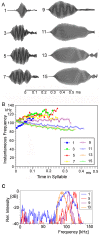Fiddler on the tree--a bush-cricket species with unusual stridulatory organs and song
- PMID: 24643071
- PMCID: PMC3958512
- DOI: 10.1371/journal.pone.0092366
Fiddler on the tree--a bush-cricket species with unusual stridulatory organs and song
Abstract
Insects of the order Orthoptera are well-known for their acoustic communication. The structures used for this purpose show a high diversity which obviously relates to differences in song parameters and to the physics of sound production. Here we describe song and morphology of the sound producing organs of a tropical bush-cricket, Ectomoptera nepicauda, from East Africa. It has a very unusual calling song consisting of frequency-modulated, pure-tone sounds in the high ultrasonic range of 80 to 120 kHz and produced by extremely fast wing movements. Concerning morphology, it represents the most extreme state in the degree of left-right fore-wing differentiation found among Orthoptera: the acoustic parts of the left fore-wing consist exclusively of the stridulatory file, comparable in function to the bow of a violin, while the right wing carries only the plectrum ( = string) and mirror ( = soundbox).
Conflict of interest statement
Figures







References
-
- Bethoux O (2012) Grylloptera – a unique origin of the stridulatory file in katydids, crickets, and their kin (Archaeorthoptera). Arthropod Syst Phylogeny 70: 43–68.
-
- Bennet-Clark HC (1989) Songs and the physics of sound production. In: Huber F, Moore TE, Loher W, editors. Cricket behavior and neurobiology. Ithaca & London: Cornell University Press. pp: 227–261.
-
- Elliott CJH, Koch UT (1983) Sensory feedback stabilizing reliable stridulation in the field cricket Gryllus campestris . Anim Behav 31: 887–901.
-
- Forrest TG (1987) Sinistrality in the southern and tawny mole crickets (Gryllotalpidae: Scapteriscus). Fla Entomol 70: 284–286.
-
- Bennet-Clark HC (1970) The mechanism and efficiency of sound production in mole crickets. J Exp Biol 52: 619–652.
Publication types
MeSH terms
LinkOut - more resources
Full Text Sources
Other Literature Sources

